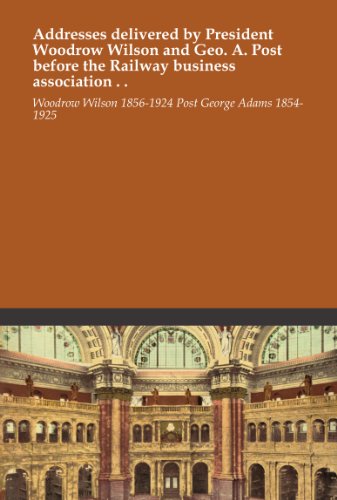Background
He was born on September 1, 1854 in Cuba, Allegany County, New York, United States, the son of Ira Allen and Harriet Newell (Curtis) Post. His father was a conductor and station agent on the Erie Railway.



(This reproduction was printed from a digital file created...)
This reproduction was printed from a digital file created at the Library of Congress as part of an extensive scanning effort started with a generous donation from the Alfred P. Sloan Foundation. The Library is pleased to offer much of its public domain holdings free of charge online and at a modest price in this printed format. Seeing these older volumes from our collections rediscovered by new generations of readers renews our own passion for books and scholarship.
https://www.amazon.com/Addresses-delivered-President-business-association/dp/B003TXT1YQ?SubscriptionId=AKIAJRRWTH346WSPOAFQ&tag=prabook-20&linkCode=sp1&camp=2025&creative=165953&creativeASIN=B003TXT1YQ
manufacturer politician statesman
He was born on September 1, 1854 in Cuba, Allegany County, New York, United States, the son of Ira Allen and Harriet Newell (Curtis) Post. His father was a conductor and station agent on the Erie Railway.
He was educated in the public schools of Tioga County, New York, the Oswego Academy, and at the Normal School of Oswego, New York.
On April 1, 1873, he became a clerk in the freight office of the Erie Railway at Susquehanna, Pennsylvania, remaining in the employ of this company in various minor capacities until November 1883.
He took an active part in local politics and was elected mayor of Susquehanna in February 1877, serving one year. During this time he studied law in the evenings and in August 1881 was admitted to the bar of Susquehanna County and commenced practice in Montrose, Pennsylvania. In 1883 he bought a half interest in the Montrose Democrat and edited the paper until March 1, 1889.
He was elected as a Democrat to the House of Representatives of the Forty-eighth Congress (March 4, 1883 - March 3, 1885), and he served on various committees. He was chosen secretary of the Democratic Congressional Committee of Pennsylvania for the campaign of 1884, and was a delegate to the national convention of his party for that year. The following year he was chairman of the Pennsylvania Democratic State Convention.
He abandoned his political activities in 1889 and moved to New York City where he joined the staff of the New York World, remaining there until 1891 when he became interested in the Standard Coupler Company. He was vice-president of this company from 1892 to 1894 and its president from 1894 until 1921, when he resigned to establish the George A. Post Company of New York, a firm dealing in railway materials and supplies, of which he was president until his death. As chairman of the executive committee of a temporary association of railway supply manufacturers in 1904, he helped organize the permanent Railway Supply Manufacturers' Association and was chairman of the committee on general arrangements for the American Railway Appliance Exhibition held in connection with the convention of the International Railway Congress at Washington, in 1905.
He was elected the first president of the Railway Business Association, serving until 1918, when he declined reelection and became chairman of the Railroad Committee of the Chamber of Commerce of the United States. For a time he served as president of the Hudson River Bridge & Terminal Association and as a trustee of the New Jersey State Chamber of Commerce.
He died in Somerville, New Jersey.
George Adams Post was the youngest member of the U. S. House of Representatives at the time. He developed the Transportation Act of 1920 and in upholding it after its passage. Besides, he was the founder and the president of the Railway Business Association composed of manufacturers of railway materials and equipment, contractors in railway construction, and dealers in railway supplies. He was one of the owners and editors of the Montrose Democrat.
(This reproduction was printed from a digital file created...)
He believed that there was a need for an association of the suppliers of railroad equipment to protect the purchasing power of the railroads against government regulation and public opinion and to promote constructive railroad legislation.
He married Minnie C. Munson on June 22, 1881, by whom he had one son.
